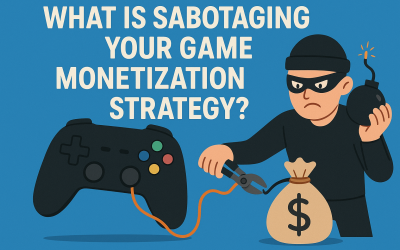Boost Your Web Monetization Earnings with Rewarded Video Ads
As the internet evolves, so do the strategies for monetizing content, demanding more user-friendly and engaging methods to keep up with user expectations and technological advancements.
Traditionally, web monetization involved direct sales, banner ads, and subscriptions that often disrupted the user experience or led to ad fatigue. Unlike traditional ads, rewarded video ads offer users a value exchange — watch an ad, receive a reward. This model is particularly effective because it respects the user’s choice and time, providing tangible benefits in exchange for their attention.
This shift towards user-centric advertising has made rewarded video ads a powerful tool in the arsenal of web monetization strategies. These ads are not just a way to enhance user experience but also a strategy to ensure sustainable revenue growth. They have been successfully implemented across various platforms, especially in gaming and media, where user engagement is crucial.
The purpose of this article is to delve deeper into how rewarded video ads can be integrated into web monetization strategies to unlock new revenue streams.
Contents
The Role of Rewarded Video Ads in Web Monetization
Continuing my “Boost Your Web Monetization Earnings with Rewarded Video Ads” post, , Rewarded video ads fit seamlessly into the broader landscape of web monetization by offering an alternative that is both user-centric and revenue-generating. This model is particularly appealing in an era where users have become more averse to intrusive ads and are wary of sharing personal data. Rewarded videos provide a transparent and voluntary way for users to support content creators and platforms without feeling pressured or exploited.
Types of Rewards Offered
 The success of rewarded video ads hinges on the appeal of the rewards offered. These rewards must be valuable enough to motivate users to opt-in to watch ads voluntarily. Here are some common types of rewards that can be tailored to fit various user preferences and platform objectives:
The success of rewarded video ads hinges on the appeal of the rewards offered. These rewards must be valuable enough to motivate users to opt-in to watch ads voluntarily. Here are some common types of rewards that can be tailored to fit various user preferences and platform objectives:
- Access to Premium Content: One of the most straightforward rewards is access to premium content that would otherwise be behind a paywall. This could include detailed articles, special video content, or access to an ad-free experience for a set period.
- Virtual Goods and In-Game Currency: For web-based games and interactive platforms, offering virtual goods or currency can be highly effective. This might include special items, exclusive skins, additional lives, or in-game money that players can use to enhance their gaming experience.
- Temporary Subscription Perks: Another rewarding approach is to offer temporary subscription benefits. For example, users could watch ads in exchange for a day of premium subscription features such as offline access, enhanced functionalities, or additional storage space on a service.
- Discounts and Coupons: Rewarding users with discounts or coupons for services or products can be a great incentive, especially for e-commerce platforms. Watching ads could unlock a percentage off their next purchase or offer free shipping.
- Donation to Charity: Some platforms choose to appeal to users’ altruistic side by offering to donate to a charity in return for watching ads. This method not only engages users but also supports good causes, enhancing the brand’s image.
- Extended Trials and Samples: Users may be offered extended trial periods or samples of premium services and products. For instance, watching a series of ads could unlock an extended trial of a premium music streaming service or a sample chapter of a paid e-book.
By choosing the right type of reward, platforms can significantly increase the likelihood that users will engage with rewarded video ads, thereby enhancing overall monetization efforts without compromising on user experience.
Integrating Rewarded Video Ads into Your Web Platform
Continuing my “Boost Your Web Monetization Earnings with Rewarded Video Ads” post, Integrating rewarded video ads into a web platform is a strategic move that can enhance your monetization efforts significantly. This process involves several technical and strategic considerations to ensure that the ads are not only effective but also seamless for the user experience. Using platforms like AppLixir can streamline this integration, offering robust solutions tailored for web-based environments.
Technical Considerations for Implementing Rewarded Video Ads
Before diving into the integration process, it’s crucial to understand the technical aspects that ensure a smooth and efficient implementation:
- Ad Placement and User Flow: Decide where the rewarded video ads will appear on your site. This placement should be strategic, ensuring it feels natural and not intrusive. The user flow should lead naturally to the opportunity to watch an ad, without disrupting the core activities on the platform.
- Loading and Performance: Rewarded video ads should load quickly and run smoothly to maintain a positive user experience. Ensure that your web platform can handle the additional load of video content without slowing down other functionalities.
- Mobile Responsiveness: Given the significant number of users on mobile devices, ensure that rewarded video ads are fully responsive. They should adapt seamlessly to different screen sizes and orientations.
- Privacy and Data Security: Adhere to privacy regulations such as GDPR or CCPA. Ensure that user data collected through video ads is handled securely and transparently.
- Fallback Mechanisms: Not all users will be able to or want to view video ads. Implement fallback mechanisms for users who skip ads or have an ad blocker installed.
 Common Platforms and Tools Supporting Rewarded Video Ads
Common Platforms and Tools Supporting Rewarded Video Ads
Several platforms and tools can help you implement rewarded video ads effectively. Here are a few notable ones:
- AppLixir: Specializes in rewarded video ads for web and mobile platforms, ideal for a variety of websites including gaming and educational sites.
- Google AdMob: Often used for mobile apps but also has solutions for web apps, including rewarded ads.
- Unity Ads: A good choice if you are running a gaming website, especially if it’s built with Unity WebGL.
- Vungle: Provides high-quality video ads, including rewarded video options for mobile and web platforms.
By following these steps and utilizing platforms like AppLixir, you can effectively integrate rewarded video ads into your web monetization strategy. This integration not only enhances user engagement but also boosts revenue in a user-friendly manner.
Best Practices for Maximizing Revenue with Rewarded Video Ads
Continuing my “Boost Your Web Monetization Earnings with Rewarded Video Ads” post, Maximizing revenue from rewarded video ads requires a careful balance between monetization and user experience. The goal is to optimize ad placements and frequencies in a way that enhances user engagement without being intrusive. Here are some best practices to achieve this balance and measure the effectiveness of your ad strategy.
- Strategic Placement:
- Natural Breakpoints: Place ads at natural stopping points within the user journey. In gaming, this could be between levels or after a game over. For educational content, consider placing ads between lessons or chapters.
- User Initiated: Ensure ads are user-initiated and not auto-played. This gives users control, making them more likely to view the ads.
- Rewards Center: Create a dedicated “Rewards Center” where users can choose to watch ads at their convenience to earn rewards. This transparency builds trust and enhances the user experience.
- Appropriate Frequency:
- Limit Views: Cap the number of ads a user can watch in a day to prevent burnout. Adjust this cap based on user engagement and feedback.
- Variable Rewards: Implement a diminishing return on rewards for repeated views to encourage users to engage with the content itself, not just the ads.
- Timely Offers: Time your rewarded ad offers based on user behavior and preferences. After significant achievements or when users are running low on resources, they are more likely to accept ad offers.
- User Experience Focus:
- Loading Times: Ensure that ads load quickly and efficiently. Delays can deter users from choosing to watch ads.
- Quality Content: Use high-quality and relevant ad content to maintain user interest and trust.
- Clear Rewards: Clearly communicate what rewards the user will receive. This transparency can increase the likelihood of ad engagement.
Measuring Effectiveness with Key Performance Indicators (KPIs)
To understand the impact of rewarded video ads, monitor the following KPIs:
- Average Revenue Per User (ARPU):
Calculate ARPU specifically for rewarded video ads by dividing the total revenue generated from these ads by the number of users who watched them.
:∗∗=/∗∗Formula:∗∗ARPU=TotalRewardedAdRevenue/NumberofEngagedUsers∗∗
Use this metric to gauge the revenue impact of these ads on your user base.
- Engagement Rates:
View Rate: The percentage of users who choose to watch rewarded ads when presented.
Completion Rate: The percentage of ads watched to completion. High completion rates often indicate that the ad content is well-matched with your audience.
Interaction Rate: Measure how users interact with the ads (clicks, follows, etc.). This can provide insights into user interest and the quality of ad content.
- User Retention and Lifetime Value (LTV):
Monitor changes in user retention rates pre- and post-implementation of rewarded ads. A positive impact suggests a good balance between monetization and user experience.
Evaluate the LTV of users engaging with ads versus those who don’t. Increased LTV can indicate successful integration of ads into the user experience.
In my “Boost Your Web Monetization Earnings with Rewarded Video Ads” post, we explored the strategic integration and optimization of rewarded video ads to enhance web monetization strategies, focusing on best practices for ad placement and frequency to ensure a positive user experience. We detailed how platforms like AppLixir facilitate the seamless integration of these ads, and we emphasized measuring their effectiveness using key performance indicators such as Average Revenue Per User (ARPU) and engagement rates. The guide also highlighted the importance of balancing monetization efforts with user experience by using strategies like user feedback, segmented approaches, and transparent communication, all aimed at maintaining a loyal user base while maximizing revenue potential.




